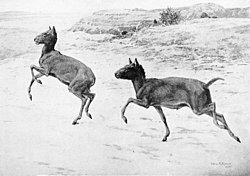| Proterotheriidae Temporal range: | |
|---|---|
 | |
| Skeleton of Thoatherium | |
| Scientific classification | |
| Kingdom: | Animalia |
| Phylum: | Chordata |
| Class: | Mammalia |
| Order: | † Litopterna |
| Suborder: | † Lopholipterna |
| Superfamily: | † Proterotherioidea |
| Family: | † Proterotheriidae Ameghino 1887 |
| Synonyms | |
| |
Proterotheriidae is an extinct family of litoptern ungulates known from the Eocene-Late Pleistocene of South America. Members of the group were small to medium-sized cursorial herbivores with brachydont teeth, with their toes showing progressive reduction, with later members of the group bearing weight on a single large toe similar to living horses. [1]









